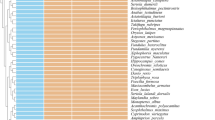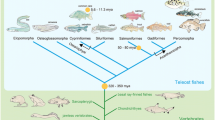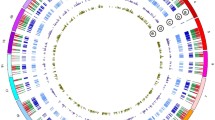Abstract
The circadian clock is a central oscillator that coordinates endogenous rhythms. Members of six gene families underlie the metabolic machinery of this system. Although this machinery appears to correspond to a highly conserved genetic system in metazoans, it has been recognized that vertebrates possess a more diverse gene inventory than that of non-vertebrates. This difference could have originated in the two successive rounds of whole-genome duplications that took place in the common ancestor of the group. Teleost fish underwent an extra event of whole-genome duplication, which is thought to have provided an abundance of raw genetic material for the biological innovations that facilitated the radiation of the group. In this study, we assessed the relative contributions of whole-genome duplication and small-scale gene duplication to generate the repertoire of genes associated with the circadian clock of teleost fish. To achieve this goal, we annotated genes from six gene families associated with the circadian clock in eight teleost fish species, and we reconstructed their evolutionary history by inferring phylogenetic relationships. Our comparative analysis indicated that teleost species possess a variable repertoire of genes related to the circadian clock gene families and that the actual diversity of these genes has been shaped by a variety of phenomena, such as the complete deletion of ohnologs, the differential retention of genes, and lineage-specific gene duplications. From a functional perspective, the subfunctionalization of two ohnolog genes (PER1a and PER1b) in zebrafish highlights the power of whole-genome duplications to generate biological diversity.



Similar content being viewed by others
References
Amores A, Force A, Yan YL, Joly L, Amemiya C, Fritz A, Ho K, Langeland J, Prince V, Wang YL, Westerfield M, Ekker M, Postlethwait JH (1998) Zebrafish hox clusters and vertebrate genome evolution. Science 282:1711–1714
Amores A, Suzuki T, Yan Y, Pomeroy J, Singer A, Amemiya C, Postlethwait J (2004) Developmental roles of Pufferfish Hox clusters and genome evolution in ray-fin fish. Genome Res 14:1–10
Amores A, Catchen J, Ferrara A, Fontenot Q, Postlethwait JH (2011) Genome evolution and meiotic maps by massively parallel DNA sequencing: spotted gar, an outgroup for the teleost genome duplication. Genetics 188:199–808
Anisimova M, Gil M, Dufayard JF, Dessimoz C, Gascuel O (2011) Survey of branch support methods demonstrates accuracy, power, and robustness of fast likelihood-based approximation schemes. Syst Biol 60:685–699
Arnegard ME, Zwickl DJ, Lu Y, Zakon HH (2010) Old gene duplication facilitates origin and diversification of an innovative communication system-twice. Proc Natl Acad Sci 51:22172–221777
Brunet F, Crollius H, Paris M, Aury J, Gibert P, Jaillon O, Laudet V, Robinson-Rechavi (2006) Gene loss and evolutionary rates following whole-genome duplication in teleost fishes. Mol Biol Evol 23:1808–1816
Christoffels A, Koh EGL, Chia J, Brenner S, Aparicio S, Venkatesh B (2004) Fugu genome analysis provides evidence for a whole-genome duplication early during the evolution of ray-finned fishes. Mol Biol Evol 21:1146–1151
Danilova D, Krupnik VE, Sugden D, Zhdanova I (2004) Melatonin stimulate cell proliferation in Zebrafish embryo and accelerate its development. FASEB J 18:751–753
Devlin PF (2002) Sings of the tie: environmental input to the circadian clock. J Exp Bot 53:1535–1550
Douard V, Brunet F, Boussau B, Ahrens-Fath I, Vlaeminck-Guillem V, Haendler B, Laudet V, Guiguen Y (2008) The fate of the duplicated androgen receptor in fishes: a late neofunctionalization event? BMC Evol Biol. doi:10.1186/1471-2148-8-336
Dunlap JC (1999) Molecular bases for circadian clock. Cell 96:271–290
Florea L, Souvorov A, Kalbfleisch TS, Salzberg SL (2011) Genome assembly has a major impact on gene content: a comparison annotation in two Bos taurus assemblies. PLoS ONE 6:e21400
Force A, Lynch M, Pickett FB, Amores A, Yan Y, Postlethwait J (1999) Preservation of duplicate genes by complementary, degenerative mutations. Genetics 151:1531–1545
Gil M, Serrano Zanetti M, Zoller S, Anisimova M (2013) Codonphyml: fast maximum likelihood phylogeny estimation under codon substitution model. Mol Biol Evol 30:1270–1280
Goldman N, Yang Z (1994) A codon-based model of nucleotide substitution for protein-coding DNA sequences. Mol Biol Evol 11:725–736
Hashiguchi Y, Nishida M (2007) Evolution of trace amine associated receptor (TAAR) gene family in vertebrates: lineage-specific expansions and degradations of a second class of vertebrate chemosensory receptors expressed in the olfactory epithelium. Mol Biol Evol 24:2099–2107
Hoegg S, Meyer A (2007) Phylogenomic analyses of KCNA clusters in vertebrates: why do some clusters stay intact? BMC Evol Biol 7:139
Hoegg S, Brinkmann H, Taylor JS, Meyer A (2004) Phylogenetic timing of the fish-specific genome duplication correlates with the diversification of teleost fish. J Mol Evol 59:190–203
Jaillon O, Aury J, Brunet F, Petit JL, Stange-Thomann N, Mauceli E, Bouneau L, Fischer C, Ozouf-Costaz C, Bernot A, Nicaud S, Jaffe D, Fisher S, Lutfalla G, Dossat C, Segurens B, Dasilva C, Salanoubat M, Levy M, Boudet N, Castellano S, Anthouard V, Jubin C, Castelli V, Katinka M, Vacherie B, Bie´mont C, Skalli Z, Cattolico L, Poulain J, De Berardinis V, Cruaud C, Duprat S, Brottier P, Coutanceau JP, Gouzy G, Parra G, Lardier G, Chapple C, McKernan KJ, McEwan P, Bosak S, Kellis M, Volff JN, Guigo R, Zody MC, Mesirov J, Lindblad-Toh K, Birren B, Nusbaum C, Kahn D, Robinson-Rechavi M, Laudet V, Schachter V, Que´tier F, Saurin W, Scarpelli C, Wincker P, Lander ES, Weissenbach J, Roest Crollius H (2004) Genome duplication in the teleost fish Tetraodon nigroviridis reveals the early vertebrate proto-karyotype. Nature 431:946–957
Jobb G, von Haeseler A, Strimmer K (2004) Treefinder: a powerful graphical analysis environment for molecular phylogenetics. BMC Evol Biol 4:18
Kasahara M, Naruse K, Sasaki S, Nakatani Y, Qu W, Ahsan B, Yamada T, Nagayasu Y, Doi K, Kasai Y, Jindo T, Kobayashi D, Shimada A, Toyoda A, Kuroki Y, Fujiyama A, Sasaki T, Shimizu A, Asakawa S, Shimizu N, Hashimoto S, Yang J, Lee Y, Matsushima K, Sugano S, Sakaizumi M, Narita T, Ohishi K, Haga S, Ohta F, Nomoto H, Nogata K, Morishita T, Endo T, Shin-I T, Takeda H, Morishita S, Kohara Y (2007) The Medaka draft genome and insights into vertebrate genome evolution. Nature 447:714–719
Katoh K, Asimenos G, Toh H (2009) Multiple alignment of DNA sequences with MAFFT. Methods Mol Biol 537:39–64
Kobayashi Y, Ishikawa T, Hirayama J, Daiyasu H, Kanai S, Toh H, Fukuda I, Tsujimura T, Terada N, Kamei Y, Yuba S, Iwai A, Todo T (2000) Molecular analysis of Zebrafish photolyase/cryptochrome family: two types of cryptochromes present in Zebrafish. Genes Cell 5:725–738
Lister JA, Close J, Raible DW (2001) Duplicate mitf genes in zebrafish:complementary expression and conservation of melanogenic potential. Dev Biol 237:333–344
Meyer A, Van de Peer Y (2005) From 2R to 3R: evidence for a fish-specific genome duplication (FSGD). BioEssays 27:937–945
Mulley JF, Chiu CH, Holland PW (2006) Breakup of a homeobox cluster after genome duplication in teleost. Proc Natl Acad Sci USA 103:10369–10372
Nelson JS (2006) Fishes of the world. Hoboken, New Jersey
Opazo JC, Butts GT, Nery MF, Storz JF, Hoffmann FG (2013) The role of whole-genome duplication in promoting the functional diversification of teleost fish hemoglobins. Mol Biol Evol 30:140–153
Postlethwait JH, Woods IG, Ngo-Hazelett P, Yan YL, Kelly PD, Chu F, Huang H, Hill-Force A, Talbot WS (2000) Zebrafish comparative genomics and the origins of vertebrate chromosomes. Genome Res 10:1890–1902
Reppert S, Weaver DR (2001) Molecular analysis of mammalian circadian rhythms. Annu Rev Physiol 63:647–676
Ronquist F, Huelsenbeck JP (2003) Mrbayes 3: Bayesian phylogenetic inference under mixed models. Bioinformatics 19:1572–1574
Sato Y, Nishida M (2007) Post-duplication charge evolution of phospho-glucose isomerases in teleost fishes through weak selection on many amino acid sites. BMC Evol Biol 7:204
Sato Y, Nishida M (2010) Teleost fish with specific genome duplication as unique models of vertebrate evolution. Environ Biol Fishes 88:169–188
Siegel N, Hoegg S, Salzburger W, Braasch I, Meyer A (2007) Comparative genomics of Parahox cluster of teleost fishes: gene cluster breakup and the retention of genes sets following whole genome duplication. BMC Genome 8:312
Tatusova TA, Madden TL (1999) BLAST2 Sequences a new tool for comparing protein and nucleotide sequence. FEMS Microbiol Lett 177:187–188
Taylor JS, Van de Peer Y, Braasch I, Meyer A (2001) Comparative genomics provides evidence for an ancient genome duplication event in fish. Phil Trans R Soc B 356:1661–1679
Taylor JS, Braasch I, Frickey T, Meyer A, Van de Peer Y (2003) Genome duplication, a trait shared by 22,000 species of ray-finned fish. Genome Res 13:382–390
Van de Peer Y, Taylor JS, Meyer A (2003) Are all fishes ancient polyploids? J Struct Funct Genomics 3:65–73
Vatine G, Vallone D, Appelbaum L, Mracek P, Ben-Moshe Z, Lahiri K, Gothilf Y, Foulkes NS (2009) Light directs zebrafish period 2 Expression via conserved D and E boxes. PLoS Biol 7:10
Wang H (2008a) Comparative analysis of teleost fish genomes reveals preservation of different ancient clock duplicates in different fishes. Mar Genomics 1:69–78
Wang H (2008b) Comparative analyses of period genes in teleost fish genomes. J Mol Evol 67:29–40
Wang H (2009) Comparative genomic analysis of teleost fish bmal genes. Genetica 136:149–161
Yu WP, Yew K, Rajasegaran V, Venkatesh B (2007) Sequencing and comparative analysis of fugu protocadherin clusters reveal diversity of protocadherin genes among teleost. BMC Evol Biol 7:49
Acknowledgments
This work was supported by Grants from the Fondo Nacional de Desarrollo Científico y Tecnológico (FONDECYT 1120032) to JCO and from the Programa de Mejoramiento de la Calidad y la Equidad de la Educación Superior (MECESUP AUS1203). JTV holds a MECESUP (AUS0703) doctoral fellowship. JIA holds a CONICYT doctoral fellowship. We also thank Espiritu del Elqui for helpful comments and edits.
Author information
Authors and Affiliations
Corresponding authors
Electronic supplementary material
Below is the link to the electronic supplementary material.
Rights and permissions
About this article
Cite this article
Toloza-Villalobos, J., Arroyo, J.I. & Opazo, J.C. The Circadian Clock of Teleost Fish: A Comparative Analysis Reveals Distinct Fates for Duplicated Genes. J Mol Evol 80, 57–64 (2015). https://doi.org/10.1007/s00239-014-9660-x
Received:
Accepted:
Published:
Issue Date:
DOI: https://doi.org/10.1007/s00239-014-9660-x




